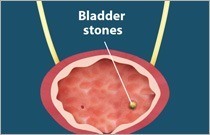What are bladder stones?

What is it?
Bladder stones form in the urine as a result of the minerals and salts being too concentrated in the bladder.
What causes it?
Bladder outlet obstruction preventing effective bladder emptying. This can result from prostate gland enlargement.
Bladder wall having impaired contractility. This can be due to damage to the nerves controlling the bladder such as a spinal injury or as a result of long term bladder outlet obstruction.
Chronic urinary retention- unable to empty bladder effectively of urine
Foreign bodies in the bladder such as urinary catheters that become encrusted
Urinary tract infections resulting in infection stones produced by certain bacteria
How does the condition affect you?
A stone in the bladder may not produce any symptoms even if large, unless it damages or irritates the bladder wall or obstructs the flow of urine.
What are the symptoms?
Symptoms include lower abdominal pain, painful and difficult urination, penile pain, and bloody or cloudy urine.
What are the consequences of not treating it?
Left untreated, a bladder stone may result in urinary tract infection and long-term difficulty with urination.
How is it diagnosed?
Your doctor may discover an asymptomatic bladder stone incidentally on an imaging study performed for another condition. When you present with symptoms of a bladder stone, your doctor will perform a thorough physical examination and examine your bladder and prostate for enlargement. Your urine is examined for infection, blood and crystallised minerals. Imaging studies such as a CT or X-ray are ordered to visualise the stone.
What are the treatment options?
If the stone is small, we may recommend increasing your fluid intake to help pass the stone out through the urine.
For larger stones, we recommend a procedure called a cystoscopy and litholapaxy. A telescope with a camera at the end is inserted into the urethra and advanced into the bladder. The stones are then broken into small particles by a holmium laser and washed out of the bladder at the same time. For more complicated stones, a small incision may be necessary in which the stone is removed directly from the bladder through an opening in the skin.
During the removal of any stones, if possible any associated underlying conditions are also treated at the same time. An example is treating an enlarged prostate gland at the same time by carrying out a holmium laser enucleation prostatectomy (HoLEP) if this condition is the cause of the bladder stones.
- Click here to download Bladder Stones info sheet
You will need the Adobe Reader to view and print these documents.![]()





 Menu
Menu


